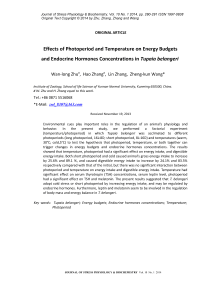Effects of photoperiod and temperature on energy budgets and endocrine hormones concentrations in Tupaia belangeri
Автор: Zhu Wan-Long, Zhang Hao, Zhang Lin, Wang Zheng-Kun
Журнал: Журнал стресс-физиологии и биохимии @jspb
Статья в выпуске: 1 т.10, 2014 года.
Бесплатный доступ
Environmental cues play important roles in the regulation of an animal’s physiology and behavior. In the present study, we performed a factorial experiment (temperature/photoperiod) in which Tupaia belangeri was acclimated to different photoperiods (long photoperiod, 16L:8D; short photoperiod, 8L:16D) and temperatures (warm, 30 oC; cold,5 oC) to test the hypothesis that photoperiod, temperature, or both together can trigger changes in energy budgets and endocrine hormones concentrations. The results showed that temperature, photoperiod had a significant effect on energy intake, and digestible energy intake. Both short photoperiod and cold caused animal's gross energy intake to increase by 25.6% and 89.1 %, and caused digestible energy intake to increase by 24.1% and 83.5% respectively compared with that of the initial, but there was no significant interaction between photoperiod and temperature on energy intake and digestible energy intake. Temperature had significant effect on serum thyrotropin (TSH) concentrations, serum leptin level, photoperiod had a significant effect on TSH and melatonin. The present results suggested that T. belangeri adapt cold stress or short photoperiod by increasing energy intake, and may be regulated by endocrine hormones. Furthermore, leptin and melatonin seem to be involved in the regulation of body mass and energy balance in T. belangeri.
Tupaia belangeri, energy budgets, endocrine hormones concentrations, temperature, photoperiod
Короткий адрес: https://sciup.org/14323839
IDR: 14323839
Текст научной статьи Effects of photoperiod and temperature on energy budgets and endocrine hormones concentrations in Tupaia belangeri
Seasonal changes of body mass influenced by environment temperature, photoperiod, quality or quantity of food and other ecological factors, temperature and photoperiod, acts as most important factors in the natural environment, had obvious effect on the animal's body mass, energy intake and the heat production (Abelenda et al., 2003). To cope with winter or cold conditions, some small mammals enhanced resting metabolic rate (RMR) and nonshivering thermogenesis (NST), and NST is an important mechanism for heat production (Bartness et al., 2002). Cold temperature can also increased energy intake and food utilization efficiency (Hayes and Chappell, 1986). Photoperiod is one of the important environmental factors to effect the animal’s behavioral and physiological during seasonal variation (Lynch, 1973). Many mammals using periodic changes as a signal to seasonal physiological changes, especially the energy balance and heat production (Li et al., 2004).
Thyroid-stimulating hormone (TSH) is a hormone that stimulates the thyroid gland to produce T 4 , and then T 3 which stimulates the metabolism of almost every tissue in the body (Parmentier et al ., 1989). Melatonin is a naturally occurring indoleamine molecule found in animals, plants, and microbes. In mammals, circulating levels of the hormone melatonin vary in a daily cycle, thereby allowing the entrainment of the circadian rhythms of several biological functions, change in duration of melatonin secretion thus serves as a biological signal for the organization of day lengthdependent (photoperiodic) seasonal functions such as reproduction and behaviors in seasonal animals (Arendt and Skene, 2005). Leptin is a 16 kDa protein hormone that plays a key role in regulating energy intake and energy expenditure, including appetite and metabolism, it had been indicated that leptin is a potential signal that mediates the seasonal variations of body mass and energy balance (Klingenspor et al ., 2000).
Tupaia belangeri (Mammalia: Scandentia: Tupaiidae) live at the highest latitude, with the Yunnan-Kweichow Plateau being its northern limit (Wang et al., 1991). Previous studies demonstrate that environmental factors, such as short photoperiods and cold, are effective cues that influence body mass, thermogenesis, triiodothyronine (T3) and thyroxine (T4) in T. belangeri (Wang et al., 1999). However, we know nothing about the effects of photoperiod and temperature on energy budgets and endocrine hormones concentrations in T. belangeri. In the present study, we examined the effect on endocrine hormones concentrations in T. belangeri under different photoperiod and temperature for 4 weeks. We predicted that photoperiod, temperature, or both together can trigger changes in energy budgets and endocrine hormones concentrations.
MATERIALS AND METHODS
Samples
T. belangeri were captured (25°25´-26°22´ N, 102°13´-102°57´ E, 1679 m in altitude) around boscage at Luquan County in 2012. The average yearly temperature was 15.6 °C, mean monthly temperature ranges from 7.8 °C in winter to 19.6 °C in summer. After being captured, T. belangeri were brought and bred at the School of Life Sciences, Yunnan Normal University, Kunming (1910 m in altitude). Each weight-matched tree shrew was housed individually in a wire cage (40 cm×40 cm×40 cm) with no bedding; all animals (40 males) were healthy adults. The photoperiod, ambient temperature and humidity were maintained at 12L: 12D (light on at 0800 h), 25 (±1)°C , and 85%–92% relative humidity, respectively. After 1 month stabilization, animals were randomly assigned to the following four experimental regimes in the animal house: long photoperiod (LD, 16: 8 L: D, with lights on at 0400) and warm (30°C), LD and cold (5°C), short photoperiod (SD, 8: 16 L: D, with lights on at 0800) and warm, and SD and cold (n=10/group) for 4 weeks. T. belangeri were fed mixed food containing 25.0% crude protein, 6.3% crude fat, 4.6% crude fibred, 7.4% ash, and 0.96 kJ/g gross energy (Zou et al., 1991); every two-day interval apples, pears, other fruits, and water were provided ad libitum. T. belangeri were fed once daily at 10:00 h. On day 0, 7, 14, 21 and 28, body mass were weighed, then animals were killed and blood was centrifuged at 800 g for 30 min, and serum was sampled and stored at -20 °C for later measurement. Pregnant, lactating or young individuals were excluded.
Measurement of energy budgets
Energy intake was measured for 7-day intervals as described previously (Song and Wang, 2002). The energy content of the food was 23.68 ±0.68 kJ/g kJ per gram dry matter, as measured by bomb calorimetry (GR23500), with the approximate composition of 69.1% young chickenfeed feed, 2.7% Whole Milk Powder, 6.9% sugar and 21.3% flour, cooked feed. Experiment adopted food balance in metabolic cage, during each test, Tree shrews were housed individually in stainless steel mesh metabolic cage (350×300×250mm3), in which food and water were provided ad libitum . Uneaten food, feces and urine were collected after the 7-day test, and separated manually and oven-dried at 65 oC for at least 72 h. The caloric values of food and feces were determined by GR23500 oxygen bomb calorimeter that is made in ChangSha Instrument Factory. Gross energy intake, digestible energy, and digestibility were calculated by the following equations (Drozdz, 1975):
Gross energy intake (kJ/day) =Dry matter intake (g/day) × Food caloric value (kJ/g dry matter)
Feces energy (kJ/day) = Dry feces (g/day) × Feces caloric value (kJ/g dry matter)
Urine energy (kJ/day)= = Dry urine (g/day) ×Urine caloric value (kJ/g dry matter)
Digestible energy intake (kJ/day) = Gross energy intake (kJ/day) - Feces energy (kJ/day)
Digestibility (%) =Digestible energy intake (kJ/day)/Gross energy intake (kJ/day) ×100%
Metabolizable energy (kJ/day) = Digestible energy intake (kJ/day)-Urine energy (kJ/day)
Assimilation rate (kJ/day)= Metabolizable energy (kJ/day)/ Digestible energy intake (kJ/day) Measurement of hormone concentration
Serum leptin levels were determined by radioimmunoassay (RIA) with the 125I Multi-species Kit (Cat. Linco Research Inc.).The lowest level of leptin that can be detected by this assay was 1.0 ng/ml when using a 100-μl sample size. And the inter- and intra-assay variability for leptin RIA were <3.6% and 8.7%, respectively. Serum insulin concentrations were measured by radioimmunoassay (RIA) with a 125I human kit (Atom HighTech Co., Ltd., Beijing, CHN). The lower and upper limits of the assay kit were 5 and 160 ng ml-1 and the intra- and inter-assay variations were <10 and 15%, respectively. Serum melatonin concentrations were measurement by ELISA method (Bioteke Co. Beijing, China). Thyroid stimulating hormone (TSH) concentrations were determined by radioimmunoassay kit (Linco Co. USA) (Du and You, 1992).
Statistical analysis
Data were analyzed using SPSS 15.0 software package. Prior to all statistical analyses, data were examined for assumptions of normality and homogeneity of variance, using Kolmogorov-Smirnov and Levene tests, respectively. Throughout the acclimation, changes in energy budgets and endocrine hormones concentrations were analyzed by a two-way analysis of covariance (ANCOVA) with body mass as a covariate. Results were presented as mean ± SEM, and P < 0.05 was considered to be statistically significant.
RESULTS
Body mass
Prior to acclimation, no group differences were found between acclimation T. belangeri (P>0.05).
During the acclimation, photoperiod and temperature had significant effects on body mass, and there was a significant interaction between photoperiod and temperature among groups (temperature effect, F=71.131, P<0.01; photoperiod effect, F=3.103, P<0.05; interaction temperature×photoperiod, F=2.162, P<0.05; fig 1). Energy budgets
Prior to acclimation, no group differences were found in energy intake, digestible energy intake and metabolizable energy between acclimation T. belangeri (P>0.05). During the acclimation, photoperiod and temperature had significant effects on energy intake, but there was no significant interaction between photoperiod and temperature among groups (temperature effect, F=58.793, P<0.01; photoperiod effect, F=5.005, P<0.05; interaction temperature×photoperiod, F=0.215, P>0.05; fig 2). Photoperiod and temperature also had significant effects on digestible energy intake and metabolizable energy, but there was no significant interaction between photoperiod and temperature among groups (temperature effect, F=59.661, P<0.01; photoperiod effect, F=5.07, P<0.05; interaction temperature×photoperiod, F=1.693, P>0.05; fig 3), (temperature effect, F=25.364, P<0.01; photoperiod effect, F=7.228, P<0.05; interaction temperature×photoperiod, F=3.005, P>0.05; fig 4). Both short photoperiod and cold caused animal's gross energy intake to increase by 25.6% and 89.1 %, and caused digestible energy intake to increase by 24.1% and 83.5% respectively compared with that of the initial.
During the acclimation, photoperiod and temperature had significant effects on digestibility and assimilation rate, but there was no significant interaction between photoperiod and temperature among groups (temperature effect, F=11.355, P<0.01; photoperiod effect, F=5.362, P<0.05; interaction temperature×photoperiod, F=0.985, P>0.05; fig 5), (temperature effect, F=5.636, P<0.01; photoperiod effect, F=3.025, P<0.05; interaction temperature×photoperiod, F=1.450, P>0.05; fig 6).
Endocrine hormones concentrations
During the acclimation, photoperiod and temperature had significant effects on TSH concentrations, but there was no significant interaction between photoperiod and temperature among groups (temperature effect, F=5.08, P<0.05; photoperiod effect, F=3.928, P<0.05; interaction temperature×photoperiod, F=0.123, P>0.05; fig 7). During the acclimation, temperature had a significant effect on serum leptin level, but there was no significant differences were found in photoperiod, interaction between photoperiod and temperature among groups (temperature effect, F=4.453, P<0.05; photoperiod effect, F=0.019, P>0.05; interaction temperature×photoperiod, F=0.003, P>0.05; fig 8). During the acclimation, photoperiod had a significant effect on serum melatonin level, but there was no significant differences were found in temperature, interaction between photoperiod and temperature among groups (temperature effect, F=0.92, P>0.05; photoperiod effect, F=6.844, P<0.05; interaction temperature×photoperiod, F=0.331, P>0.05; fig 9).
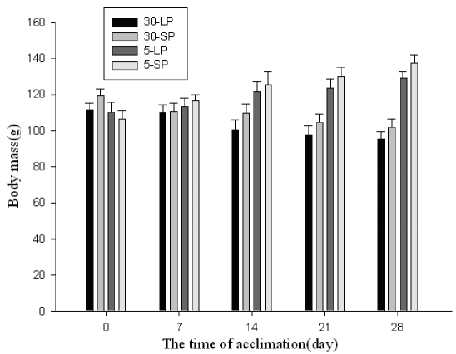
Figure 1 : Effects of temperature and photoperiod on body mass in Tupaia belangeri
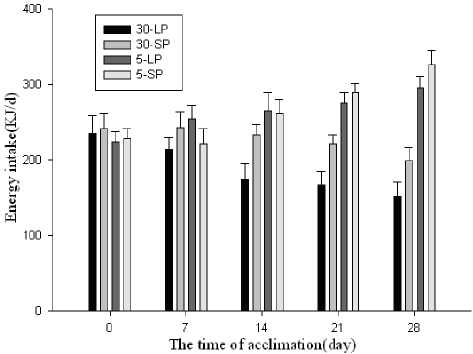
Figure 2. Effects of temperature and photoperiod on energy intake in Tupaia belangeri
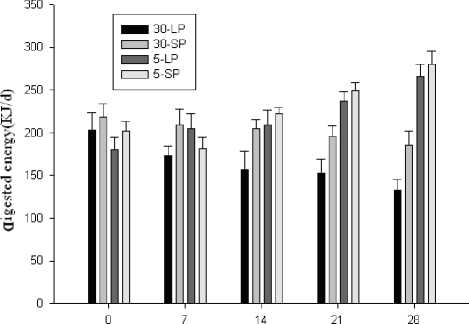
Hie time of ;HelimahoiH day)
Figure 3. Effects of temperature and photoperiod on digestible energy intake in Tupaia belangeri
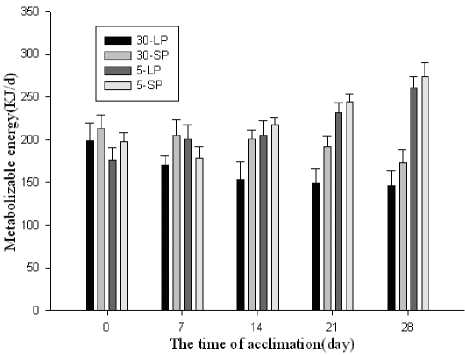
Figure 4 . Effects of temperature and photoperiod on metabolizable energy in Tupaia belangeri
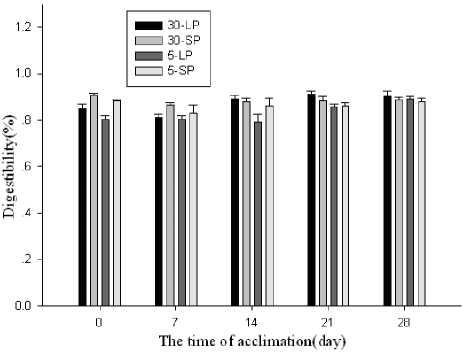
Figure 5 . Effects of temperature and photoperiod on digestibility in Tupaia belangeri

Figure 6 . Effects of temperature and photoperiod on assimilation rate in Tupaia belangeri
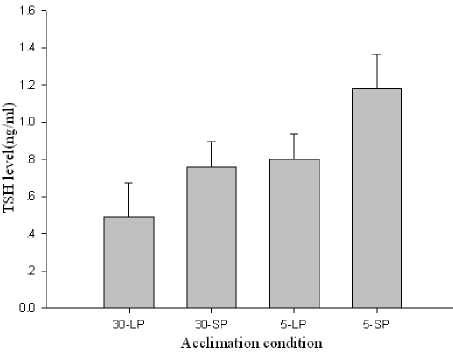
Figure 7. Effects of temperature and photoperiod on TSH concentrations in Tupaia belangeri
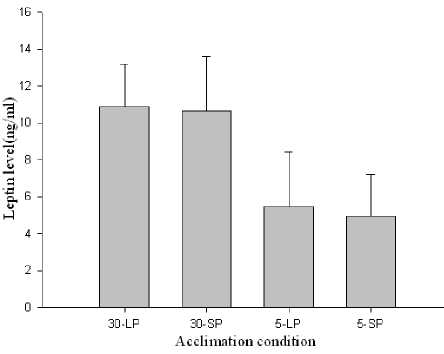
Figure 8. Effects of temperature and photoperiod on serum leptin level in Tupaia belangeri
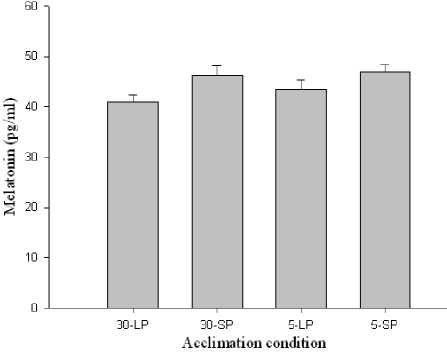
Figure 9. Effects of temperature and photoperiod on serum melatonin level in Tupaia belangeri
DISCUSSION
Body mass
Balance of body mass was determined between energy intake and expenditure, many small mammals reduced body mass in winter-like condition (Bartness et al., 2002), such as Microtus ochrogaster (Voltura and Wunder, 1998), M pennsylvanic (Iverson and Turner, 1974). In contrast, some small mammals increased body mass under cold acclimation, such as Dicrostonga groenlandicus (Nagy and Negus, 1993). When the long photoperiod transform to short photoperiod, Dicrostonyx groenlandicus increased body mass significantly (Nagy et al., 1995), while Phodopus sungorus decreased body mass significantly, mainly related with the change of energy intake (Knopper and Boily, 2000). Body mass in T. belangeri gradually increased under cold temperature and short photoperiod, which was similar to the results that under seasonal acclimatized (Zhu et al., 2012). Changes of body mass in T. belangeri was different to the mammals lived in north area, there may be two reasons, one was that increasing in body mass was advantageous in decreasing heat loss of individuals and increasing the capacity during cold tolerance (Li et al., 2001), another was that probably related with the special distribution of T. belangeri, T. belangeri distributed in tropical and subtropical plateau area in Indo China Peninsula, compared with the high latitude area, the low temperature stress seems to be weak, food resources adequate relatively, adequate food can amount to compensate for the energy consumption caused by low temperature stress, therefore, by increasing food intake to increase energy consumption, this may be one of the causes of body mass gain at low temperature of T. belangeri.
Energy budgets
Energy metabolism levels play an important role in the decision of the distribution, reproductive success and fitness in small mammals (Bozinovic, 1992). Many studies showed that energy balance showed seasonal obvious changes (Klingenspor et al ., 2000). Cols temperature is an important factor to impact energy metabolism in animals (Hayes and Chappell, 1986). Some animals through increased energy intake and utilization of stored energy to compensate for the cold caused by increase of energy consumption, such as Apodemus chevrieri
(Zhu et al ., 2011), Eothenomys miletus (Zhu et al ., 2010). Our results showed that the temperature had significant effect on energy intake and digestible energy intake. Compared with before domestication, low temperature makes the energy intake increased 89.1%, digestible energy intake increased 83.5%. These results indicated that s energy intake and digestible energy intake were affected significantly by temperature in tree shrew, which was similar to the and study by Zhang (Zhang et al ., 2012).
Photoperiod is an important environmental factor to affect body mass and energy metabolism in small mammals (Heldmaier et al., 1989), such as Mesocricetus auratus (Knopper and Boily, 2000), Dicrostonyx groenlandicus (Nagy et al., 1995). However, different species have different reactions to the photoperiod changes, such as short photoperiod lead Phodopus sungorus decreased body mass and energy intake (Heldmaier et al., 1989); and under the same conditions, Dicrostonys groenlandicus increased body mass, but energy intake did not change (Genin and Perret, 2000). Our results showed that photoperiod can affect metabolism can significantly on the energy intake and digestible energy intake, there were no significant effects of interaction between temperature and photoperiod. Compared with before domestication, short photoperiod makes the energy intake, digestible energy intake increased 25.6%, 24.1%, respectively. These results suggested that in addition to temperature, photoperiod is an important factor affecting energy budget. The study found that energy intake and digestible energy intake was affected by photoperiod, which was related to that tree shrew was a non hibernating species, must face the cold winter, and short photoperiod induced tree shrew to increase in energy intake to compensate heat production in the winter (Li et al., 2004).
Endocrine hormones concentrations
Thyroid hormones play an important role in the regulation of mammalian adaptive thermogenesis (McNabb, 1992). Thyroid hormones levels ac affect RMR and NST in small mammals (Himms-Hagen, 1983). In the present study, photoperiod and temperature had significant effects on TSH concentrations, but there was no significant interaction between photoperiod and temperature among groups, which was similar to Sigmokon hispidus (Tomasi and Mitchell, 1996). Under cold condition, the secretion of leptin gene expression was inhibited, and the serum leptin concentration decreased (Tomothy and Wade, 1985). Injection of melatonin in some small mammals can stimulate some rodents thermogenesis capacity enhancement to resist the low temperature stress (Heldmaier and Lynch, 1986). Therefore, melatonin is an important endocrine hormone to regulate seasonal changes of energy metabolism (Nelson and Demas, 1997). In the present study, temperature had a significant effect on serum leptin level, but there was no significant differences were found in photoperiod, interaction between photoperiod and temperature among groups. Photoperiod had a significant effect on serum melatonin level, but there was no significant differences were found in temperature, interaction between photoperiod and temperature. Serum leptin level was lower in cold temperature, and serum melatonin level was higher in short photoperiod. Tree shrew increased energy intake significantly under cold temperature, probably because of the cold temperature stimulation decreased serum leptin level, thus causing hunger signals, thus increased energy intake, which suggested that leptin may be involved in regulation of heat production. Moreover, short photoperiod enhanced heat production ability of tree shrew, which may be due to short photoperiod induced increased levels of melatonin, so melatonin can enhance and stimulate the adaptive thermogenesis ability in tree shrews.
In conclusion, the present results suggested T. belangeri overcome winter-like conditions by adjusting energy intake and endocrine hormones concentrations. Furthermore, leptin and melatonin may play an potential role in thermogenesis regulation in T. belangeri .
ACKNOWLEDGMENTS
This research was financially supported by the National Key Technology Research and Development Program (No. 2014BAI01B00), International cooperation in science and technology project (SQS2014RR102), National Science Foundation of China (No. 31260097; 31360096), Basilic Project of Yunnan Province (No. 2013FA014).
Список литературы Effects of photoperiod and temperature on energy budgets and endocrine hormones concentrations in Tupaia belangeri
- Abelenda, M., Ledesma, A., Bial, E. (2003) Leptin administration to cold acclimated rats reduce both food intake and brown adpose tissue thermogenesis. J Therm Biol, 28: 525-530
- Arendt, J. AND Skene, D.J., 2005. Melatonin as a chronobiotic. Sleep Med Rev., 9 (1): 25-39
- Bartness, T.J., Demas, G.E., Song, C.K. (2002) Seasonal changes in adiposity: the roles of the photoperiod, melatonin and other hormones, and sympathetic nervous system. Exp. Biol. Med., 227 (6): 363-376
- Bozinovic, F. (1992) Rate of basal metabolismof grazing rodents from different habitats. J Mamm, 73 (2): 379-384
- Drozdz, A. (1975) Metabolic cages for small rodents. In: Grodzinski W, Klekowski R Z, Duncan A eds: Methods for Ecological Bioenergetics. Oxford: Blackwell Scientific Press, 346-351
- Du, J.Z., You, Z.B., (1992) A radioimmunoassay of corticotrophin releasing factor of hypothalamus in Ochotona curzoniae. Acta Theriol. Sin., 12 (3): 223-229
- Genin, F., Perret, M. (2000) Photoperiod induced changes in energy balance in gray mouse lemurs. Physiol Behav, 71: 315-321
- Hayes, J.P., Chappell, M.A. (1986) Effects of cold acclimation on maximum oxygen consumption during cold exposure and treadmill exercise in deer mice Peromyscus maniculatus. Physiol Zool, 59: 453-459
- Heldmaier, G., Lynch, G.R. (1986) Pineal involvement in thermoregulation and acclimatization. Res Rev, 4: 97-139
- Heldmaier, G., Steinlechner, S., Ruf, T., Wiesinger, H., Kingenspor, M. (1989) Photoperiod and thermoregulation in vertebrate: body temperature rhythms and thermogenic acclimation. J Biol Rhythm, 4: 251-265
- Himms-Hagen, J. (1983) Thyroid hormones and thermogenesis. In: Mammalia Thermogenesis. Edited by Giraardie L and Stock M J. New York: Chapman and Hall, 141-177
- Iverson, S.L., Turner, B.N. (1974) Winter weight dynamics in Microtus pennsylvanicus. Ecology, 55: 1030-1041
- Klingenspor, M., Niggemann, H., Heldmaier, G. (2000) Modulation of leptin sensitivity by short photoperiod acclimation in the Djungarian hamster, Phodopus sungorus. J. Comp. Physiol. B, 170: 37-43
- Knopper, L.D., Boily, P. (2000) The energy budget of captive Siberian hamsters, Phodopus sungorus, exposed to photoperiod changes: Mass loss is caused by a voluntary decrease in food intake. Physiol Biochem Zool, 73(4): 517-522·
- Li, Q.F., Sun, R.Y., Huang, C.X., Wang, Z.K., Liu, X.T., Hou, J.J., Liu, J.S., Cai, L.Q., Li, N., Zhang, S.Z., Wang, Y. (2001) Cold adaptive thermogenesis in small mammals from different geographical zones of China. Comp. Biochem. Physiol., 129: 949-961
- Li, X.S., Wang, D.H., Yang, M. (2004) Effects of cold acclimation on body weight, serum leptin level, energy metabolism and thermogenesis in the Mongolian gerbil Meriones unguiculatus. Acta Zool. Sin., 50; 334-340
- Lynch G.R. (1973) Seasonal changes in thermogenesis, organ weights, and body composition in the white-footed mouse Peromyscus lucopus. Oecologia, 13: 363-376
- McNabb, F.M.A. (1992) Thyroid-hormones, their activation, degradation and effects on metabolism. J Nutr., 125: 1773-1776
- Nagy, T.R., Gower, B.A., Stetson, M.H. (1995) Endocrine correlates of seasonal body mass dynamics in the collared lemming Dicrostonyx groenlandicus. Amer. Zool, 35: 246-258
- Nelson, R.J., Demas, G.E. (1997) Role of melatonin in mediating seasonal energetic and immunologic adaptations. Brain Res Bull, 44 (4): 423-430
- Parmentier, M., Libert, F., Maenhaut, C., Lefort, A., Gérard, C., Perret, J., Van-Sande, J., Dumont, J.E., Vassart, G. (1989) Molecular cloning of the thyrotropin receptor. Science, 246(4937): 1620-1622
- Song, Z.G., Wang, D.H. (2002) Relationships between metabolic rates and body composition in the Mongolian gerbil (Meriones unguiculatus). Acta Zoologica Sinica, 48: 445-451
- Tomasi, T.E., Mitchell, D.A. (1996) Temperature and photoperiod effects on thyroid function and metabolism in cotton rats (Sigmodon hispidus). Com Biochem Physiol, 113: 267-274
- Tomothy, J.B., Wade, G.N. (1985) Photoperiodic control of seasonal body weight cycles in hamsters. Neurosci Biobehav R, 9: 599-612
- Voltura, M.B., Wunder, B.A. (1998) Effects of ambient temperature, diet quality, and food restriction on body composition dynamics of the prairie vole Microtus ochrogaster. Physiol. Zool., 71(3): 321-328
- Wang, Y.X., Li, C.Y., Ma, S.L. (1991) The classification and ecology of tree shrews. In: Peng, Y., Ye, Z., Zou, R. Eds. Biology of Chinese Tree shrews (Tupaia belangeri Chinensis). Yunnan Scientic and Technological Press, Kunming
- Wang, Z.K., Li, Q.F., Sun, R.Y., Liu, L. (1999) Effects of photoperiod and temperature on thermogenesis in the tree shrew (Tupaia belangeri). Acta Zoologica Sinica, 45: 287-293
- Zhang, L., Liu, P., Zhu, W., Cai, J., Wang, Z. (2012) Variations in thermal physiology and energetics of the tree shrew (Tupaia belangeri) in response to cold acclimation. J. Comp. Physiol. B, 182: 167-176
- Zhu, W.L., Jia, T., Lian, X., Wang, Z.K. (2010) Effects of cold acclimation on body mass, serum leptin level, energy metabolism and thermognesis in Eothenomys miletus in Hengduan Mountains region. J. Therm. Biol., 35(1): 41-46
- Zhu, W.L., Wang, B., Cai, J.H., Lian, X., Wang, Z.K. (2011) Thermogenesis, energy intake and serum leptin in Apodemus chevrieri in Hengduan Mountains region during cold acclimation. J. Therm. Biol., 36(3): 181-186
- Zhu, W.L., Zhang, H., Wang, Z.K. (2012). Seasonal changes in body mass and thermogenesis in tree shrews (Tupaia belangeri) the roles of photoperiod and cold. J. Therm. Biol., 37: 479-484
- Zou, R., Ji, W., Yan, H., Lu, J. (1991) The captivities and reproductions of tree shrews. In: Peng, Y., Ye, Z., Zou, R. Eds. Biology of Chinese Tree shrews (Tupaia belangeri chinensis).Yunnan Scientic and Technological Press, Kunming

